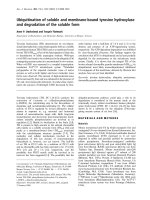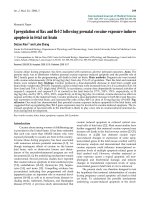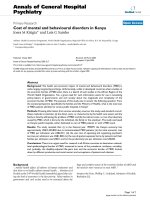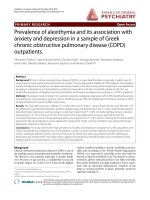Báo cáo y học: "Hypothesis of snake and insect venoms against Human Immunodeficiency Virus: a review" pot
Bạn đang xem bản rút gọn của tài liệu. Xem và tải ngay bản đầy đủ của tài liệu tại đây (475.67 KB, 5 trang )
BioMed Central
Page 1 of 5
(page number not for citation purposes)
AIDS Research and Therapy
Open Access
Review
Hypothesis of snake and insect venoms against Human
Immunodeficiency Virus: a review
Ramachandran Meenakshisundaram
1
, Shah Sweni*
2,4,5
and
Ponniah Thirumalaikolundusubramanian
3
Address:
1
Madras Medical College, Chennai, India,
2
University of Debrecen, Medical & Health Science Center, Debrecen, Hungary,
3
Chennai
Medical College Hospital & Research Center, Irungalur, Trichy, India,
4
1103, Dimple Heights, Asha Nagar, Kandivali East, Mumbai - 400101, India
and
5
Simonyi utca, 35, fldsz 30, Debrecen 4028, Hungary
Email: Ramachandran Meenakshisundaram - ; Shah Sweni* - ;
Ponniah Thirumalaikolundusubramanian -
* Corresponding author
Abstract
Background: Snake and insect venoms have been demonstrated to have beneficial effects in the
treatment of certain diseases including drug resistant human immunodeficiency virus (HIV)
infection. We evaluated and hypothesized the probable mechanisms of venoms against HIV.
Methods: Previous literatures published over a period of 30 years (1979-2009) were searched
using the key words snake venom, insect venom, mechanisms and HIV. Mechanisms were identified
and discussed.
Results & Conclusion: With reference to mechanisms of action, properties and components of
snake venom such as sequence homology and enzymes (protease or L- amino acid oxidase) may
have an effect on membrane protein and/or act against HIV at multiple levels or cells carrying HIV
virus resulting in enhanced effect of anti-retroviral therapy (ART). This may cause a decrease in
viral load and improvement in clinical as well as immunological status. Insect venom and human
Phospholipase A
2
(PLA
2
) have potential anti-viral activity through inhibition of virion entry into the
cells. However, all these require further evaluation in order to establish its role against HIV as an
independent one or as a supplement.
Background
Components of snake venom are used for health and dis-
eases[1], an interesting emerging concept. Some of the
snake venom preparations include angiotensin-convert-
ing enzyme (ACE) inhibitor, disintegrins (antiplatelet
aggregants)[2] and also used, in diagnostic assays of vari-
ous blood coagulation factors[3]. Alpha neurotoxin,
extracted from cobras has been shown to have analgesic
effects [4,5] and crotoxin from Crotalus durissus terrificus
has cytotoxic effects[6]. Recently, Alrajhi and Almo-
haizeie[7] demonstrated the usefulness of snake venom in
a patient suffering from a drug resistant human immuno-
deficiency virus (HIV) infection, who was on anti-retrovi-
ral therapy (ART). In HIV patients, the response after
administration of snake venom preparation [7,8] was an
increase in CD4 count and decrease in viral load. We have
recently shown that the components of snake venom
might enhance the activity of ART at different levels[9].
Published: 19 November 2009
AIDS Research and Therapy 2009, 6:25 doi:10.1186/1742-6405-6-25
Received: 24 August 2009
Accepted: 19 November 2009
This article is available from: />© 2009 Meenakshisundaram et al; licensee BioMed Central Ltd.
This is an Open Access article distributed under the terms of the Creative Commons Attribution License ( />),
which permits unrestricted use, distribution, and reproduction in any medium, provided the original work is properly cited.
AIDS Research and Therapy 2009, 6:25 />Page 2 of 5
(page number not for citation purposes)
Interestingly, insect venom and human secretions also
have anti-HIV activity [10-12]. Hence, we evaluated and
hypothesized the probable mechanisms of venoms and
secretions against HIV infection.
Methods
Previous literatures published over a period of 30 years
(1979-2009) were searched using the key words snake
venom, insect venom, HIV and mechanisms. Based on the
available materials, the probable mechanisms of action of
venom and secretions against HIV were identified and dis-
cussed.
Results and Discussion
Snake Venom
The pharmacological activities of snake venom are com-
plex in nature with little known about them and it varies
amongst the multitude of snake venoms. The mechanisms
of action of snake venom against HIV are mediated
through various levels [9], such as structural homology,
binding interference (receptor/enzyme), catalytic/inhibi-
tory activity through enzymes, and induction/interaction
at membrane level.
1) Structure
The HIV virus entry into cells is mediated through the
binding of envelope glycoprotein - gp120 [13]. There is a
striking homology between the sequence 164-174 of
short segment HIV-1 gp120 and the highly conserved 30-
40 amino acid residues of snake venom neurotoxins long
loop [14,15]. Thus, both may compete for the same recep-
tor or binding site and act against HIV.
F N I S T S I R G K V - HIV gp 120
C D K F C S I R G P V - alpha - cobratoxin (Naja naja sia-
mensis)
C D A F C S I R G K R - k - bungarotoxin (Bungarus multi-
cintus)
Structure 1: Amino acid sequences of HIV gp120 (164-
174) compared to alpha- cobratoxin and k- bungarotoxin
(30-40)[15].
2) Binding
a) Snake venom contains Phospholipase A
2
(PLA
2
)[11,16], which protect human primary blood
leukocytes from the replication of various macrophage
and T cell-tropic human immunodeficiency virus 1
(HIV-1) strains. PLA
2
which is found in the venom of
many snakes has been shown to block viral entry into
cells before virion uncoating through prevention of
intracellular release of viral capsid protein [16]. This is
mainly due to the specific interaction of PLA
2
to host
cells and not due to catalytic activity.
b) Immunokine - an oxidized derivative of alpha -
cobra toxin (Naja naja siamensis), has been shown to
inhibit the infection of lymphocytes by HIV and Feline
immunodeficiency virus (FIV) through chemokine
receptors (CCR 5 and CXCR 4) [17].
3) Enzymatic activity
a) L- amino acid oxidase (LAO), present in the venom of
Trimeresurus stejnegeri[18], C. Atrox, P. australis[19]; inhib-
its infection and replication of HIV virus through P24
antigen in a dose dependant manner[18]. P24 antigen is a
core protein of HIV and its level associates with viral
load[20]. Besides the binding of protein to cell mem-
brane, hydrogen peroxide (H2O2) produced as a free rad-
ical could inhibit the infection/replication of HIV, thereby
further enhancing the anti viral activity. In contrast, cata-
lase - a scavenger of H2O2, reduces the anti- viral activity
[18].
b) Protein fragment isolated from Oxyuranus scutellatus
snake venom is a potent inhibitor of p24 antigen and
blocks viral replication of resistant strains [21].
c) Snake venom contains metalloprotease inhibi-
tors[16,22] which could prevent the production of new
viruses through inhibition of protease enzymes. HIV
infects a CD4 cell of a person's body and then it copies its
own genetic code into the cell's DNA. Then, CD4 cell is
"programmed" to make new HIV genetic material and
proteins. These proteins are degraded by HIV protease
enzyme and again these proteins are used to make func-
tional new HIV particles. Protease inhibitors are used to
block the protease enzyme and prevent the cell from pro-
ducing new viruses.
4) Effect on membrane protein
P-glycoprotein (P-gp), a membrane protein, is an energy-
dependent efflux transporter driven by ATP hydroly-
sis[23]. P-gp transports a wide range of substances with
diverse chemical structures. In general, P-gp substrates
appear to be lipophilic and amphiphatic, and are recog-
nized to play an important role in processes of absorp-
tion, distribution, metabolism, and excretion of many
clinically important drugs in humans [23]. Because of its
importance in pharmacokinetics, inhibition or induction
of P-gp by various components of snake venom can lead
to significant drug-drug interactions, thereby changing the
systemic or target tissue exposure of the protease inhibi-
tors. At the same time one has to remember genetic poly-
morphism of P-gp,[23] which has also been recorded
recently, because it may affect drug disposition and pro-
duce variable drug effects.
AIDS Research and Therapy 2009, 6:25 />Page 3 of 5
(page number not for citation purposes)
Other Clinical Uses of Snake Venom
Neurotoxins from snake such as cobra venom activates
central cholinergic pathways by nicotine and nicotinic
agonists, which have been shown to elicit anti-nociceptive
effects in a variety of species and produces significant
analgesic effect [24,25]. PLA
2
inhibitors (PLI) from snake
- Habu snake, Trimeresurus flavoridis have anti-enzymatic,
anti-myotoxic, anti-edema inducing, anti-cytotoxic, and
anti-bacterial activities - [26], and hence, used in neurode-
generative disorders such as trauma, Alzhiemers disease,
Parkinson's and brain tumors - [27]. Fibrolase from A.
contorix snake venom degrade α and β chains of fibrin and
used as a thrombolytic agent [28]. Snake venom RGD-dis-
integrins showed direct interaction in several tumor cell
lines. It blocks αvβ3 integrin in tumor cells, thus inhibited
their adhesion to the extra cellular matrix and thereby pre-
vents metastasis [29]. PLA
2
from Bothrops neweidii and
Naja Naja venom, was found to be cytotoxic towards
B16F10 melanoma and Ehrlich ascitic tumor cells, as an
anti-cancer drug [30]. Crotoxin, a pre-synaptic neurotoxin
has been tried as an anti-cancer agent in advanced cancer
patients [31]. VRCTC-310, a natural product with PLA
2
from Crotalus Durissus terrificus and cardiotoxin from Naja
Naja atra, have inhibitory effect against human and
murine tumor cell lines, and have effective value in the
treatment of advanced solid cancers, which were refrac-
tory to other therapy [32].
Insect Venom
1. Gene expression
Melittin is a 26 amino acid amphipathic α-helical pep-
tide, a major component of bee venom [33]. The
cecropins are a family of antibacterial peptides 35-39
amino acids in length which occur in a number of
insect species and in mammals [34]. Like melittin,
they consist of two α-helices linked by a flexible seg-
ment, and contain amphipathic structures. Melittin
and cecropin act against a wide range of infectious
agents, including Gram-positive and Gram-negative
bacteria [35]. Whereas melittin is lytic for red blood
cells at high concentrations, cecropins do not lyse
erythrocytes or other eukaryotic cells [35] and appear
to be non-toxic for mammalian cells. Melittin has
been reported to inhibit replication of murine retrovi-
ruses, tobacco mosaic virus [36] and herpes simplex
virus [37] suggesting that melittin also displays antivi-
ral activity. Analogous to antibacterial activity, the
antiviral activity of melittin has been attributed to
direct lysis of viral membranes, as demonstrated for
murine retroviruses [38]. However, melittin also dis-
plays antiviral activity at much lower, non-virolytic
concentrations, as shown for T cells chronically
infected with HIV-1 [39]. Wachinger [10] et al.,
reported that melittin and cecropin A are shown to
suppress production of HIV-1 by acutely infected cells
and also, suppresses the HIV-1 replication by interfer-
ing with host cell-directed viral gene expression [10].
Melittin treatment of T cells reduces levels of intracel-
lular Gag and viral mRNAs, and decreases HIV long
terminal repeat (LTR) activity. Besides, HIV LTR activ-
ity is also reduced in human cells stably transfected
with melittin and cecropin genes.
2. Binding
i. Mammalian venom secreted PLA
2
have been associ-
ated with a variety of biological effects. Fernard et al
[11] suggested that PLA
2
protect human blood leuko-
cytes from the replication of various macrophage and
T cell-tropic HIV-1 strains. This is neither due to viru-
cidal nor cytotoxic effect on host cells; however PLA
2
blocks viral entry into cells before virion uncoating,
independent of the receptor. Inhibitors and catalytic
products of PLA
2
have no effect on HIV-1 infection
suggesting that PLA
2
catalytic activity is not involved in
antiviral effect.
ii. Peptide p3bv, is a 21-25 aminoacids component
from secreted phospholipases of bee venom (bvPLA
2
)
[40]. The p3bv peptide inhibits the replication of HIV-
1 through prevention of the cell fusion process medi-
ated by T-lymphotropic HIV-1 envelope without the
effect of monocytotropic HIV-1. Then, p3bv inhibits
the binding of stromal cell factor-1 α (natural ligand
of CXCR4) and 12G5 (anti-CXCR4 monoclonal anti-
body). Overall, p3bv blocks the replication of T-lym-
photropic HIV-1 strains by interacting with CXCR4,
thereby blocking viral entry into cells.
iii. PLA
2
-I A from bee, and serpent venom showed in
vitro anti-HIV activity, which was due to the ability of
secretions to destabilize anchorage (heparans) and
fusion (cholesterol) receptors on HIV target cells [41].
Human PLA
2
Interestingly, human PLA
2
(group III PLA
2
) has significant
homology with bee venom PLA
2
[42]. Several murine and
human group phospholipases such as II A, X, V, XII, II E,
I B, and II F have potential antibacterial effects against
gram positive and negative bacteria [43]. In individuals
repeatedly exposed to HIV but who remain uninfected,
several possible reasons for protection have been pro-
posed but not clearly elucidated [44].
1. Membrane
Kim et al., [12] suggested that human PLA
2
and
human group X PLA
2
(PLA
2
-X) have potential antiviral
activity against diverse lentiviruses by the degradation
of viral membrane. PLA
2
-X has high affinity for phos-
phatidylcholine, a phospholipid in outer plasma
membrane and hydrolyzes it. Viral membrane of HIV-
AIDS Research and Therapy 2009, 6:25 />Page 4 of 5
(page number not for citation purposes)
1 is rich in phosphatidylcholine and sphingomyelin
and may be more susceptible to PLA
2
-X.
2. Binding
PLA
2
-X inhibits replication of both CXCR4 and CCR5
HIV-1 in human CD4 cells. This effect was observed
despite the resistance of viral preparations to lysis by
antibody-mediated complement activation, suggest-
ing that this action occur in cases even where the
acquired immunity is ineffective[12]. In view of the
above, anitiviral activity of human PLA
2
expressed in
immune tissues and cells will be particularly interest-
ing to analyze in future [44].
Debate in PLA
2
action
Kim et al., [12] concluded that enzymatic activity of PLA
2
-
X is necessary for antiviral effect, which contradict the
findings of Fernard et al., [11] where catalytic activity was
not required. Hence, further studies are needed to ascer-
tain its exact mechanism.
Conclusion
In view of the above mechanisms, snake venom might
reduce HIV load, thereby decreasing its effect and
enhances CD4 count. Insect venom and human PLA
2
act
through PLA
2
mediated inhibition of virion entry into
host cells. Hopefully, the use of venom preparation or a
synthetic molecule similar to snake/insect venom/human
secretions without adverse effects may open a new era of
anti-retroviral therapy against HIV or act as an adjuvant
not only for HIV but also to other viral infections. How-
ever, further research is required to ascertain the exact
mechanism of antiviral activity of snake and insect ven-
oms.
List of abbreviations
HIV: human immunodeficiency virus; ART: anti-retroviral
therapy; PLA
2
: Phospholipase A
2
; HIV-1: human immun-
odeficiency virus 1; ACE: angiotensin-converting enzyme;
FIV: Feline immunodeficiency virus; LAO: L- amino acid
oxidase; H2O2: hydrogen peroxide; P-gp: P-glycoprotein;
PLI: PLA
2
inhibitors; LTR: long terminal repeat; bvPLA
2
:
phospholipases of bee venom; PLA
2
-X: human group X
PLA
2
.
Competing interests
The authors declare that they have no competing interests.
Financial disclosure
Nil
Authors' contributions
RM, SS and PT hypothesized and collected references. RM
and SS drafted the first version. PT critically revised the
manuscript. All authors read and approved the final ver-
sion.
References
1. Koh D, Armugam A, Jeyaseelan K: Snake venom components and
their applications in biomedicine. Cell Mol Life Sci 2006,
63(24):3030-3041.
2. Patlak M: From viper's venom to drug design: treating hyper-
tension. FASEB J 2004, 18(3):421.
3. Marsh NA: Diagnostic uses of snake venom. Haemostasis 2001,
31(3-6):211-217.
4. Chen ZX, Zhang HL, Gu ZL, Chen BW, Han R, Reid PF, Raymond LN,
Qin ZH: A long-form alpha-neurotoxin from cobra venom
produces potent opioid-independent analgesia. Acta Pharmacol
Sin 2006, 27(4):402-408.
5. Pu XC, Wong PT, Gopalakrishnakone P: A novel analgesic toxin
(hannalgesin) from the venom of king cobra (Ophiophagus
hannah). Toxicon 1995, 33(11):1425-1431.
6. Faure G, Harvey AL, Thomson E, Saliou B, Radvyani F, Bon C: Com-
parison of crotoxin isoforms reveals that stability of the
complex plays a major role in its pharmacological action. Eur
J Biochem 1993, 214(2):491-496.
7. Alrajhi AA, Almohaizeie A: Snake venom preparation for drug-
resistant human immunodeficiency virus. Ann Saudi Med 2008,
28(4):292-293.
8. Samayz [ />]
9. Meenakshisundaram R, Uma A, Thirumalaikolundusubramanian P:
RE: Snake venom preparation for drug-resistant human
immunodeficiency virus. Ann Saudi Med 2009, 29(2):159.
10. Wachinger M, Kleinschmidt A, Winder D, von Pechmann N, Ludvig-
sen A, Neumann M, Holle R, Salmons B, Erfle V, Brack-Werner R:
Antimicrobial peptides melittin and cecropin inhibit replica-
tion of human immunodeficiency virus 1 by suppressing viral
gene expression. J Gen Virol 1998, 79(Pt 4):731-740.
11. Fenard D, Lambeau G, Valentin E, Lefebvre JC, Lazdunski M, Doglio
A: Secreted phospholipases A(2), a new class of HIV inhibi-
tors that block virus entry into host cells. J Clin Invest 1999,
104(5):611-618.
12. Kim JO, Chakrabarti BK, Guha-Niyogi A, Louder MK, Mascola JR,
Ganesh L, Nabel GJ: Lysis of human immunodeficiency virus
type 1 by a specific secreted human phospholipase A2. J Virol
2007, 81(3):1444-1450.
13. Kwong PD, Wyatt R, Robinson J, Sweet RW, Sodroski J, Hendrickson
WA: Structure of an HIV gp120 envelope glycoprotein in
complex with the CD4 receptor and a neutralizing human
antibody. Nature 1998, 393(6686):648-659.
14. Sönnerborg A, Johansson B: The neurotoxin-like sequence of
human immunodeficiency virus GP120: A comparison of
sequence data from patients with and without neurological
symptoms. Virus Genes 1993, 7(1):23-31.
15. Neri P, Bracci L, Rustici M, Santucci A: Sequence homology
between HIV gp120, rabies virus glycoprotein, and snake
venom neurotoxins. Archives of Virology 1990, 114(3):265-269.
16. da Silva JO, Fernandes RS, Ticli FK, Oliveira CZ, Mazzi MV, Franco JJ,
Giuliatti S, Pereira PS, Soares AM, Sampaio SV: Triterpenoid
saponins, new metalloprotease snake venom inhibitors iso-
lated from Pentaclethra macroloba. Toxicon 2007,
50(2):283-291.
17. Esperanza NeuroPeptides [ />news.php]
18. Zhang YJ, Wang JH, Lee WH, Wang Q, Liu H, Zheng YT, Zhang Y:
Molecular characterization of Trimeresurus stejnegeri
venom L-amino acid oxidase with potential anti-HIV activity.
Biochem Biophys Res Commun 2003, 309(3):598-604.
19. Du XY, Clemetson KJ: Snake venom L-amino acid oxidases.
Toxicon 2002, 40(6):659-665.
20. Brown AE, Vahey MT, Zhou SY, Chung RC, Ruiz NM, Hofheinz D,
Lane JR, Mayers DL: Quantitative relationship of circulating
p24 antigen with human immunodeficiency virus (HIV) RNA
and specific antibody in HIV-infected subjects receiving
antiretroviral therapy. The RV43 Study Group. J Infect Dis
1995, 172(4):1091-1095.
21. Ophidia products Inc [ />]
Publish with BioMed Central and every
scientist can read your work free of charge
"BioMed Central will be the most significant development for
disseminating the results of biomedical research in our lifetime."
Sir Paul Nurse, Cancer Research UK
Your research papers will be:
available free of charge to the entire biomedical community
peer reviewed and published immediately upon acceptance
cited in PubMed and archived on PubMed Central
yours — you keep the copyright
Submit your manuscript here:
/>BioMedcentral
AIDS Research and Therapy 2009, 6:25 />Page 5 of 5
(page number not for citation purposes)
22. Fenard DL, Valentin E, Lefebvre JC, Lazdunski M, Doglio A: Secreted
phospholipases A(2), a new class of HIV inhibitors that block
virus entry into host cells. J Clin Invest 1999, 104:611-618.
23. Tandon V, Kapoor B, Bano G, Gupta S, Gillani Z, Kour D: P-glyco-
protein: Pharmacological relevance. Indian Journal of Pharmacol-
ogy 2006, 38(1):13-24.
24. Damaj MI, Meyer EM, Martin BR: The antinociceptive effects of
alpha7 nicotinic agonists in an acute pain model. Neurophar-
macology 2000, 39(13):2785-2791.
25. Decker MW, Meyer MD, Sullivan JP: The therapeutic potential of
nicotinic acetylcholine receptor agonists for pain control.
Expert Opin Investig Drugs 2001, 10(10):1819-1830.
26. Soares AM, Marcussi S, Stabeli RG, Franca SC, Giglio JR, Ward RJ,
Arantes EC: Structural and functional analysis of BmjMIP, a
phospholipase A2 myotoxin inhibitor protein from Bothrops
moojeni snake plasma. Biochem Biophys Res Commun 2003,
302(2):193-200.
27. Farooqui AA, Litsky ML, Farooqui T, Horrocks LA: Inhibitors of
intracellular phospholipase A2 activity: their neurochemical
effects and therapeutical importance for neurological disor-
ders. Brain Res Bull 1999, 49(3):139-153.
28. Samsa GP, Matchar DB, Williams GR, Levy DE: Cost-effectiveness
of ancrod treatment of acute ischaemic stroke: results from
the Stroke Treatment with Ancrod Trial (STAT). J Eval Clin
Pract 2002, 8(1):61-70.
29. Yeh CH, Peng HC, Yang RS, Huang TF: Rhodostomin, a snake
venom disintegrin, inhibits angiogenesis elicited by basic
fibroblast growth factor and suppresses tumor growth by a
selective alpha(v)beta(3) blockade of endothelial cells. Molec-
ular pharmacology 2001, 59(5):1333-1342.
30. Basavarajappa BS, Gowda TV: Comparative characterization of
two toxic phospholipases A2 from Indian cobra (Naja naja
naja) venom. Toxicon 1992, 30(10):1227-1238.
31. Cura JE, Blanzaco DP, Brisson C, Cura MA, Cabrol R, Larrateguy L,
Mendez C, Sechi JC, Silveira JS, Theiller E, et al.: Phase I and phar-
macokinetics study of crotoxin (cytotoxic PLA(2), NSC-
624244) in patients with advanced cancer. Clin Cancer Res 2002,
8(4):1033-1041.
32. Costa LA, Miles HA, Diez RA, Araujo CE, Coni Molina CM, Cervel-
lino JC: Phase I study of VRCTC-310, a purified phospholipase
A2 purified from snake venom, in patients with refractory
cancer: safety and pharmacokinetic data. Anti-cancer drugs
1997, 8(9):829-834.
33. Bazzo R, Tappin MJ, Pastore A, Harvey TS, Carver JA, Campbell ID:
The structure of melittin. A 1H-NMR study in methanol. Eur
J Biochem 1988, 173(1):139-146.
34. Boman HG: Peptide antibiotics and their role in innate immu-
nity. Annu Rev Immunol 1995, 13:61-92.
35. Wade D, Andreu D, Mitchell SA, Silveira AM, Boman A, Boman HG,
Merrifield RB: Antibacterial peptides designed as analogs or
hybrids of cecropins and melittin. Int J Pept Protein Res 1992,
40(5):429-436.
36. Marcos JF, Beachy RN, Houghten RA, Blondelle SE, Perez-Paya E:
Inhibition of a plant virus infection by analogs of melittin.
Proc Natl Acad Sci USA 1995, 92(26):12466-12469.
37. Baghian A, Jaynes J, Enright F, Kousoulas KG: An amphipathic
alpha-helical synthetic peptide analogue of melittin inhibits
herpes simplex virus-1 (HSV-1)-induced cell fusion and virus
spread. Peptides 1997, 18(2):177-183.
38. Esser AF, Bartholomew RM, Jensen FC, Muller-Eberhard HJ: Disas-
sembly of viral membranes by complement independent of
channel formation. Proc Natl Acad Sci USA 1979,
76(11):5843-5847.
39. Wachinger M, Saermark T, Erfle V: Influence of amphipathic pep-
tides on the HIV-1 production in persistently infected T lym-
phoma cells. FEBS letters 1992, 309(3):235-241.
40. Fenard D, Lambeau G, Maurin T, Lefebvre JC, Doglio A: A peptide
derived from bee venom-secreted phospholipase A2 inhibits
replication of T-cell tropic HIV-1 strains via interaction with
the CXCR4 chemokine receptor. Mol Pharmacol 2001,
60(2):341-347.
41. Villarubia VGCL, Diez RA: Secreted phospholipases A2
(sPLA2): friends or foes? Are they actors in antibacterial and
anti-HIV resistance? Med Clin (Barc)
2004, 123(19):749-757.
42. Valentin E, Ghomashchi F, Gelb MH, Lazdunski M, Lambeau G: Novel
human secreted phospholipase A(2) with homology to the
group III bee venom enzyme. J Biol Chem 2000,
275(11):7492-7496.
43. Koduri RS, Gronroos JO, Laine VJ, Le Calvez C, Lambeau G,
Nevalainen TJ, Gelb MH: Bactericidal properties of human and
murine groups I, II, V, X, and XII secreted phospholipases
A(2). J Biol Chem 2002, 277(8):5849-5857.
44. Stranford SA, Skurnick J, Louria D, Osmond D, Chang SY, Sninsky J,
Ferrari G, Weinhold K, Lindquist C, Levy JA: Lack of infection in
HIV-exposed individuals is associated with a strong CD8(+)
cell noncytotoxic anti-HIV response. Proc Natl Acad Sci USA
1999, 96(3):1030-1035.









